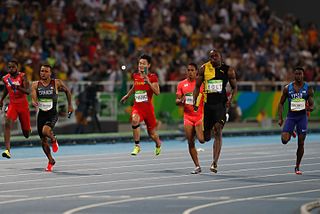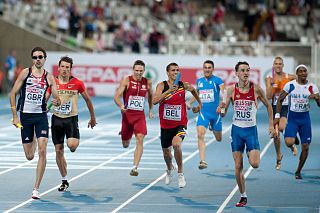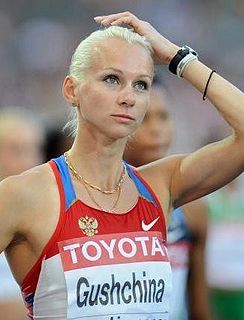
Anastasiya Alexandrovna Kapachinskaya is a Russian former sprint athlete. She was the 2003 World champion in the 200 m. She was disqualified from competitions in 2004 and 2008 due to doping offences. As a result, the bulk of her athletics performances after 2004 have been annulled.

Tatyana Romanovna Lebedeva is a Russian track and field athlete who competes in both the long jump and triple jump events. She is one of the most successful athletes in the disciplines, having won gold medals at Olympic, world and European levels. She has a long jump best of 7.33 m and had hold the indoor world record mark of 15.36 m in the triple jump.

The 4 × 100 metres relay or sprint relay is an athletics track event run in lanes over one lap of the track with four runners completing 100 metres each. The first runners must begin in the same stagger as for the individual 400 m race. Each runner carries a relay baton. Before 2018, the baton had to be passed within a 20 m changeover box, preceded by a 10-metre acceleration zone. With a rule change effective November 1, 2017, that zone was modified to include the acceleration zone as part of the passing zone, making the entire zone 30 metres in length. The outgoing runner cannot touch the baton until it has entered the zone, and the incoming runner cannot touch it after it has left the zone. The zone is usually marked in yellow, frequently using lines, triangles or chevrons. While the rule book specifies the exact positioning of the marks, the colours and style are only "recommended". While most legacy tracks will still have the older markings, the rule change still uses existing marks. Not all governing body jurisdictions have adopted the rule change.

The 4 × 400 metres relay or long relay is an athletics track event in which teams consist of four runners who each complete 400 metres or one lap. It is traditionally the final event of a track meet. At top class events, the first 500 metres is run in lanes. Start lines are thus staggered over a greater distance than in an individual 400 metres race; the runners then typically move to the inside of the track. The slightly longer 4 × 440 yards relay was a formerly run British and American event, until metrication was completed in the 1970s.

Hrysopiyi "Piyi" Devetzi is a retired Greek athlete who competed in the triple jump and long jump.

Tatyana Vladimirovna Kotova is a track and field athlete who competed for Russia in the long jump. Her personal best jump of 7.42 m at Annecy in 2002, is the best distance achieved by a female long jumper in the 21st century.
This article is about the history of competitors at the Olympic Games using banned athletic performance-enhancing drugs.
Athletics at the 2008 Summer Olympics were held during the last ten days of the games, from August 15 to August 24, 2008, at the Beijing National Stadium. The Olympic sport of athletics is split into four distinct sets of events: track and field events, road running events, and racewalking events.

Yuliya Aleksandrovna Gushchina is a Russian sprinter who specializes in the 200 metres.
The women's 4 × 400 metres relay event at the 2008 Olympic Games took place on 22 and 23 August at the Beijing Olympic Stadium.

Antonina Vladimirovna Krivoshapka is a Russian sprinter who specializes in the 400 metres. She competed at the 2012 Summer Olympics, where her team originally was awarded a silver medal in the 4 × 400 m relay. Krivoshapka and her teammates were later stripped of this medal after Krivoshapka tested positive for the steroid turinabol.

The athletics competitions at the 2012 Olympic Games in London were held during the last 10 days of the Games, on 3–12 August. Track and field events took place at the Olympic Stadium in east London. The road events, however, started and finished on The Mall in central London.

The women's 1500 metres competition was an event at the 2012 Summer Olympics in London, United Kingdom. The competition was held at the Olympic Stadium from 6–10 August. The top two finishers were later found to have used prohibited drugs during this period, and subsequently disqualified. The current silver medalist, Tatyana Tomashova, had served a two-year doping ban (2008-2010) for manipulating samples; and the 7th-place finisher Natallia Kareiva and the 9th-place finisher Yekaterina Kostetskaya were later disqualified after being found guilty of doping.

The Women's 400 metres at the 2011 World Championships in Athletics was held at the Daegu Stadium on August 27, 28 and 29.
The women's 4 × 400 metres relay at the 2013 World Championships in Athletics was held at the Luzhniki Stadium on 16–17 August.

The 200 metres at the World Championships in Athletics has been contested by both men and women since the inaugural edition in 1983. It is the second most prestigious title in the discipline after the 200 metres at the Olympics. The competition format typically has two or three qualifying rounds leading to a final between eight athletes.

The 4×100 metres relay at the World Championships in Athletics has been contested by both men and women since the inaugural edition in 1983. It is the second most prestigious title in the discipline after the 4×100 metres relay at the Olympics. The competition format typically has one qualifying round leading to a final between eight teams. As of 2015, nations can qualify for the competition through a top eight finish at the previous IAAF World Relays event, with the remaining teams coming through the more traditional route of ranking highly on time in the seasonal lists.
The 4×400 metres relay at the World Championships in Athletics has been contested by both men and women since the inaugural edition in 1983. The competition features three formats in relation to gender: men, women, and mixed. The 2019 edition added in the mixed competition. The format utilizes one set of heats qualifying the top 8 into a final.












